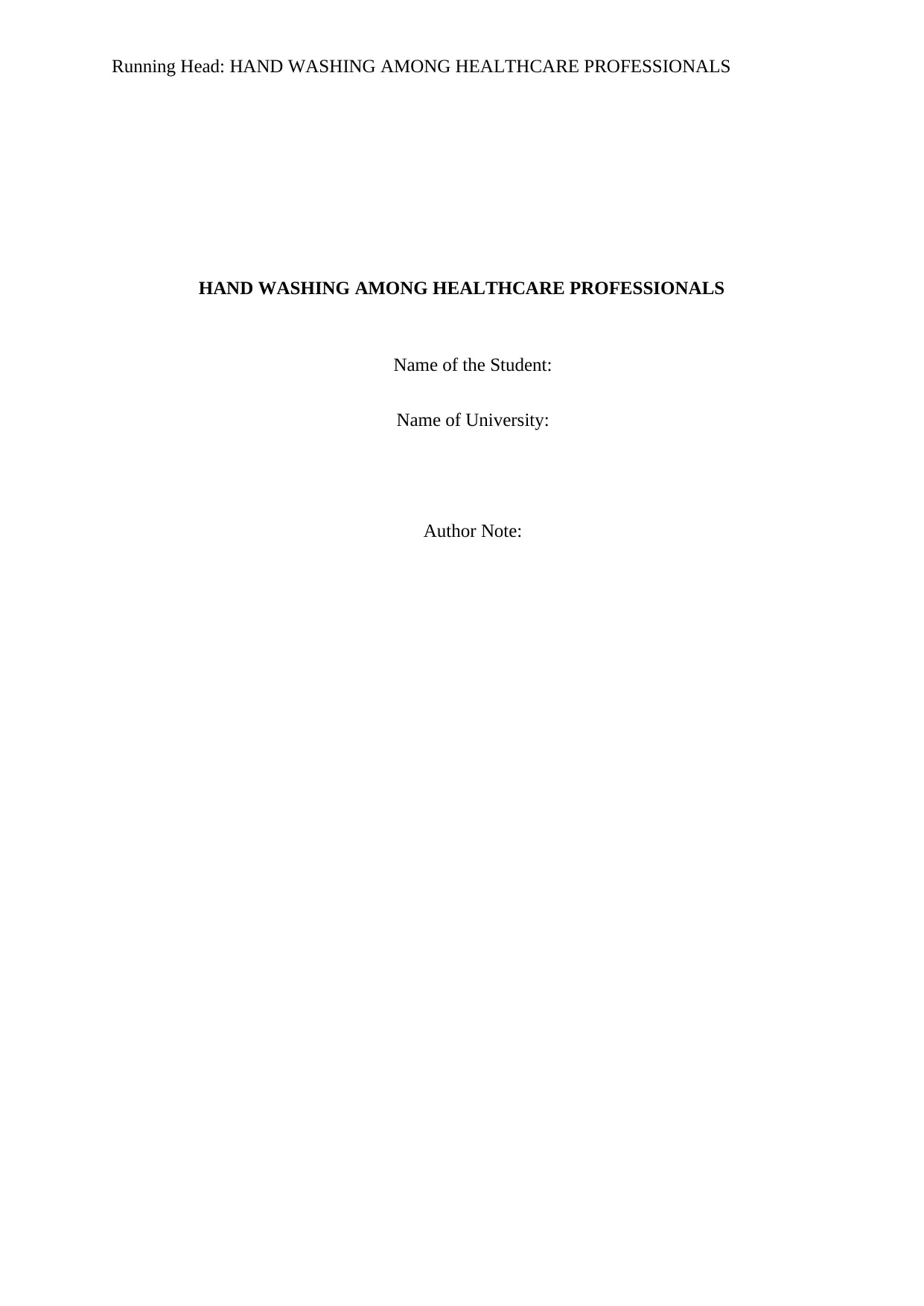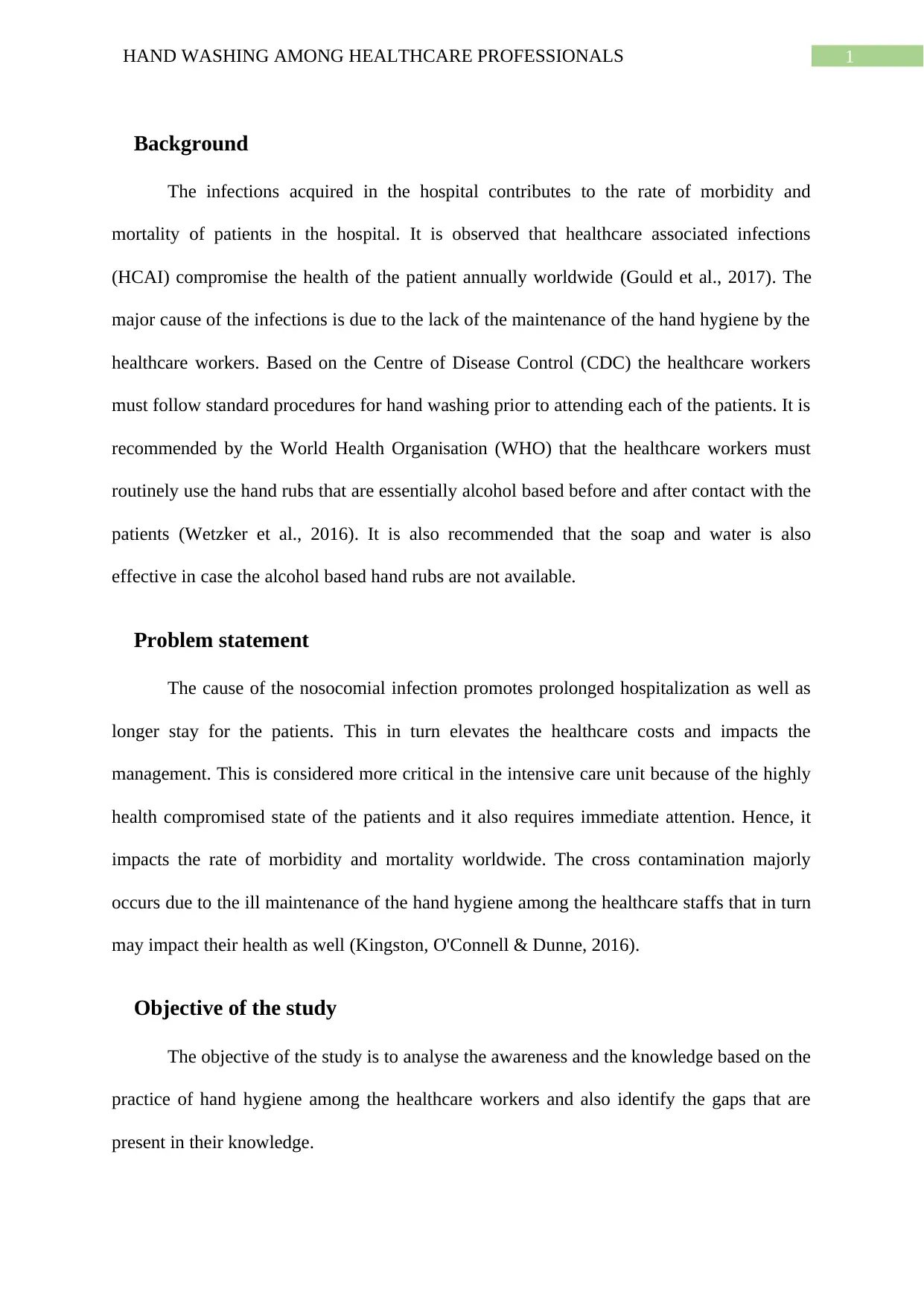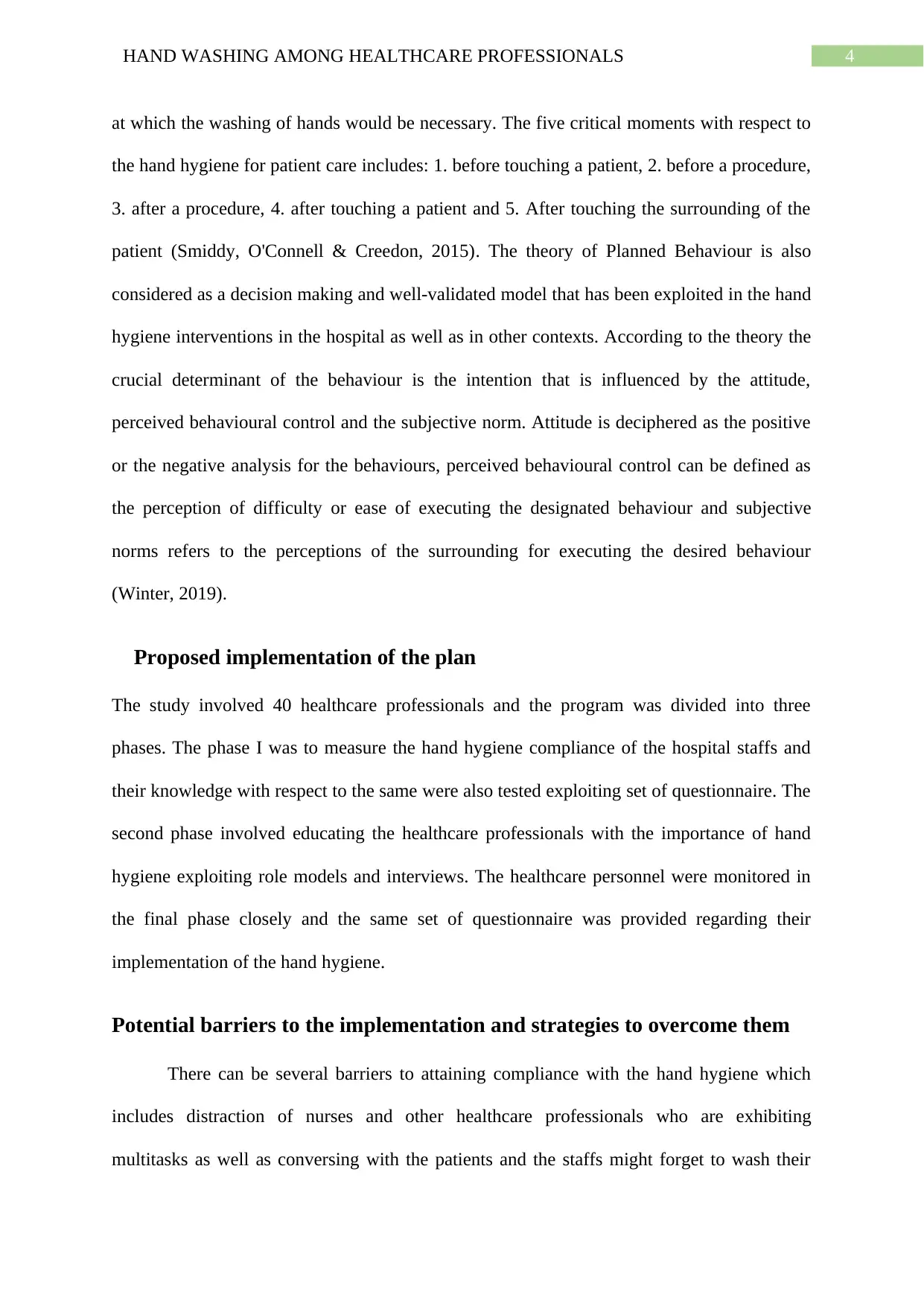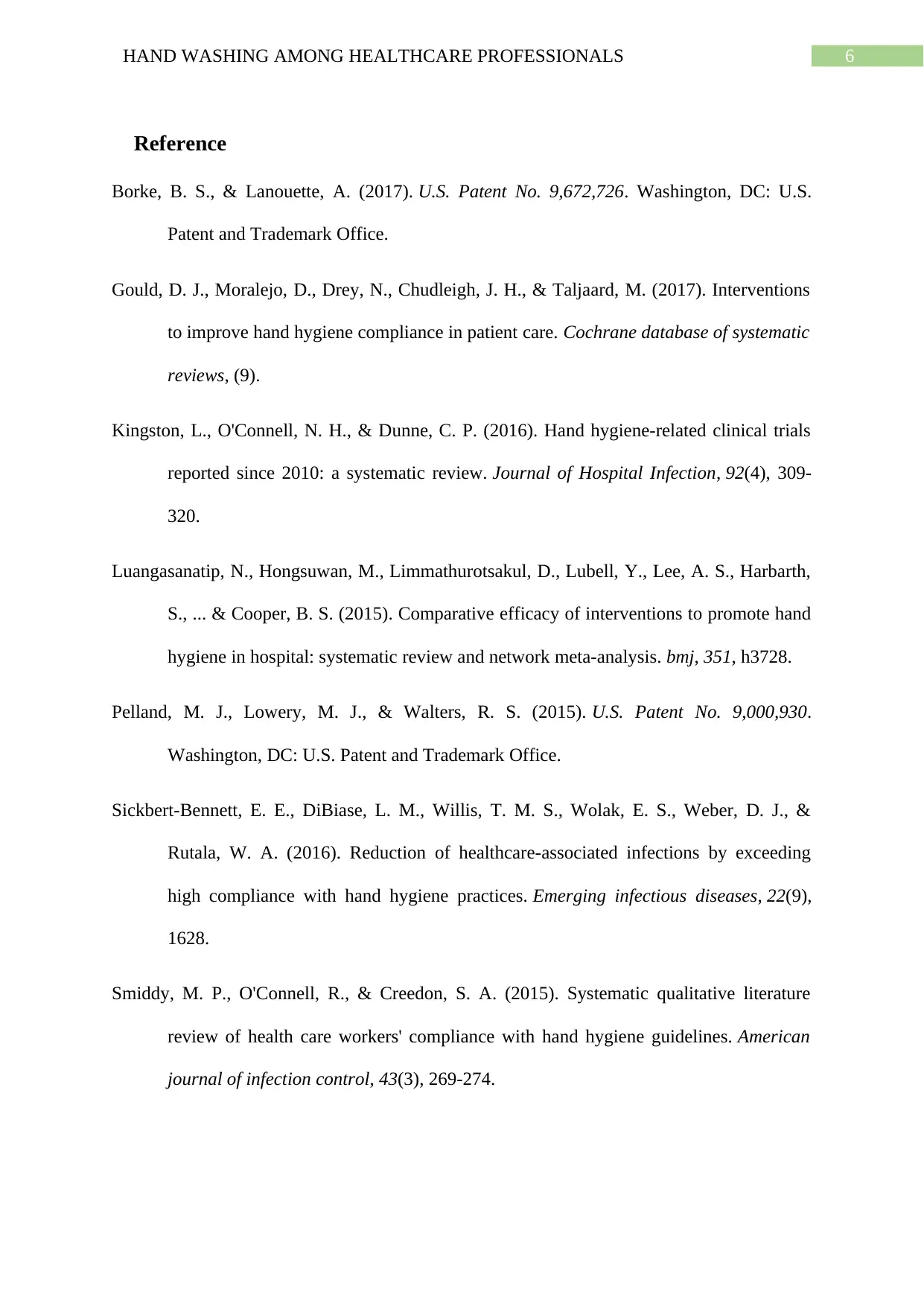Project: Hand Washing Among Healthcare Professionals - University Name
VerifiedAdded on 2022/10/01
|8
|1811
|34
Project
AI Summary
This project comprehensively investigates hand washing practices among healthcare professionals, addressing the critical issue of hospital-acquired infections (HAIs). It begins with a background on HAIs and the significance of hand hygiene, followed by a problem statement emphasizing the impact of nosocomial infections on patient outcomes and healthcare costs. The project defines the study's objective, utilizing a PICOT statement to frame the research question regarding the effectiveness of hand washing techniques in reducing HAIs. A literature review synthesizes existing research, highlighting the impact of hand hygiene compliance. The project also applies relevant nursing theories like the Nudge Theory and the Theory of Planned Behavior to understand and improve hand hygiene behavior. A proposed implementation plan outlines a three-phase program to assess, educate, and monitor healthcare professionals' hand hygiene practices. The project also addresses potential barriers to implementation, offering strategies to overcome them, and concludes with a comprehensive reference list. This project provides valuable insights into improving hand hygiene compliance and reducing the incidence of HAIs, ultimately enhancing patient safety and care.

Running Head: HAND WASHING AMONG HEALTHCARE PROFESSIONALS
HAND WASHING AMONG HEALTHCARE PROFESSIONALS
Name of the Student:
Name of University:
Author Note:
HAND WASHING AMONG HEALTHCARE PROFESSIONALS
Name of the Student:
Name of University:
Author Note:
Paraphrase This Document
Need a fresh take? Get an instant paraphrase of this document with our AI Paraphraser

1HAND WASHING AMONG HEALTHCARE PROFESSIONALS
Background
The infections acquired in the hospital contributes to the rate of morbidity and
mortality of patients in the hospital. It is observed that healthcare associated infections
(HCAI) compromise the health of the patient annually worldwide (Gould et al., 2017). The
major cause of the infections is due to the lack of the maintenance of the hand hygiene by the
healthcare workers. Based on the Centre of Disease Control (CDC) the healthcare workers
must follow standard procedures for hand washing prior to attending each of the patients. It is
recommended by the World Health Organisation (WHO) that the healthcare workers must
routinely use the hand rubs that are essentially alcohol based before and after contact with the
patients (Wetzker et al., 2016). It is also recommended that the soap and water is also
effective in case the alcohol based hand rubs are not available.
Problem statement
The cause of the nosocomial infection promotes prolonged hospitalization as well as
longer stay for the patients. This in turn elevates the healthcare costs and impacts the
management. This is considered more critical in the intensive care unit because of the highly
health compromised state of the patients and it also requires immediate attention. Hence, it
impacts the rate of morbidity and mortality worldwide. The cross contamination majorly
occurs due to the ill maintenance of the hand hygiene among the healthcare staffs that in turn
may impact their health as well (Kingston, O'Connell & Dunne, 2016).
Objective of the study
The objective of the study is to analyse the awareness and the knowledge based on the
practice of hand hygiene among the healthcare workers and also identify the gaps that are
present in their knowledge.
Background
The infections acquired in the hospital contributes to the rate of morbidity and
mortality of patients in the hospital. It is observed that healthcare associated infections
(HCAI) compromise the health of the patient annually worldwide (Gould et al., 2017). The
major cause of the infections is due to the lack of the maintenance of the hand hygiene by the
healthcare workers. Based on the Centre of Disease Control (CDC) the healthcare workers
must follow standard procedures for hand washing prior to attending each of the patients. It is
recommended by the World Health Organisation (WHO) that the healthcare workers must
routinely use the hand rubs that are essentially alcohol based before and after contact with the
patients (Wetzker et al., 2016). It is also recommended that the soap and water is also
effective in case the alcohol based hand rubs are not available.
Problem statement
The cause of the nosocomial infection promotes prolonged hospitalization as well as
longer stay for the patients. This in turn elevates the healthcare costs and impacts the
management. This is considered more critical in the intensive care unit because of the highly
health compromised state of the patients and it also requires immediate attention. Hence, it
impacts the rate of morbidity and mortality worldwide. The cross contamination majorly
occurs due to the ill maintenance of the hand hygiene among the healthcare staffs that in turn
may impact their health as well (Kingston, O'Connell & Dunne, 2016).
Objective of the study
The objective of the study is to analyse the awareness and the knowledge based on the
practice of hand hygiene among the healthcare workers and also identify the gaps that are
present in their knowledge.

2HAND WASHING AMONG HEALTHCARE PROFESSIONALS
PICOT Statement
P: Population/patient/problem
The problem I considered in the assessment is the healthcare associated infections which
cause an impact with the multi-drug resistant bacteria. This universal risk of acquiring
nosocomial infection is contributed by lack of hand hygiene to my knowledge.
I: Intervention/Indicator
The objective of my assessment was to focus on the hand hygiene. Based on the evidence
based literature I think hand hygiene is the most effective measure to control majority of the
nosocomial infection.
C: Comparison/Control
I have read that the usage of masks and other elements have not impacted and reduced the
occurrence of the nosocomial infection. Hence, I can consider that even if maintaining all the
other guidelines of the patient care and ignoring hand hygiene is similar to not executing the
effective care model.
O: Outcome
The expected and observed outcome of the assessment is that if I can implement efficacious
hand hygiene then it would effectively reduce the occurrence of the healthcare associated
infections (HCAI).
T: Time factor or the type of study
PICOT Statement
P: Population/patient/problem
The problem I considered in the assessment is the healthcare associated infections which
cause an impact with the multi-drug resistant bacteria. This universal risk of acquiring
nosocomial infection is contributed by lack of hand hygiene to my knowledge.
I: Intervention/Indicator
The objective of my assessment was to focus on the hand hygiene. Based on the evidence
based literature I think hand hygiene is the most effective measure to control majority of the
nosocomial infection.
C: Comparison/Control
I have read that the usage of masks and other elements have not impacted and reduced the
occurrence of the nosocomial infection. Hence, I can consider that even if maintaining all the
other guidelines of the patient care and ignoring hand hygiene is similar to not executing the
effective care model.
O: Outcome
The expected and observed outcome of the assessment is that if I can implement efficacious
hand hygiene then it would effectively reduce the occurrence of the healthcare associated
infections (HCAI).
T: Time factor or the type of study
⊘ This is a preview!⊘
Do you want full access?
Subscribe today to unlock all pages.

Trusted by 1+ million students worldwide

3HAND WASHING AMONG HEALTHCARE PROFESSIONALS
The study was a qualitative as well as quantitative in nature and the expected time period post
which the impact of the outcome will be evident is regular maintenance of the hospital data of
the incidence of the nosocomial infection post implementation of the hand hygiene plan.
Literature review
There is an increased mortality rate worldwide due to the inability of the health
compromised patients to combat the nosocomial infection. The transmission of the germs
occur majorly due to the contaminated hands of the healthcare personnel. The healthcare
associated pathogens are acquired from the infected wounds which might have contacted the
treated patient’s skin, gown, bed or the immediate environment (Sickbert-Bennett et al.,
2016). The organisms like Staphylococcus aureus, Proteus mirabilis, Clostridium difficile,
Klebsiella spp. and Acinetobacter spp. are usually associated with healthcare associated
infections. Evidence based literature studies have shown that practices of the appropriate
hand hygiene in the healthcare settings is associated with decreased incidence of the
nosocomial infections. It also positively impacts the overall hygiene status of the healthcare
professionals (Luangasanatip et al., 2015). But compliance of such avenues require
monitoring efforts as well as continuous improvement that would promote its effectiveness.
But it is evident from the literature studies that the adherence to hand washing is pretty low
almost 29% of the healthcare professionals in the study executed (Smiddy, O'Connell &
Creedon, 2015).
Applicable Nursing Theory
The Nudge Theory has been widely used in the nursing practice in order to improve
the healthy behaviour and also work as an external cue to the memory. WHO has proposed
guidelines in 2009 that accounts for the 5 moment model (Pelland, Lowery & Walters, 2015).
This program of 5 moment model would prompt the nurses to remember the important times
The study was a qualitative as well as quantitative in nature and the expected time period post
which the impact of the outcome will be evident is regular maintenance of the hospital data of
the incidence of the nosocomial infection post implementation of the hand hygiene plan.
Literature review
There is an increased mortality rate worldwide due to the inability of the health
compromised patients to combat the nosocomial infection. The transmission of the germs
occur majorly due to the contaminated hands of the healthcare personnel. The healthcare
associated pathogens are acquired from the infected wounds which might have contacted the
treated patient’s skin, gown, bed or the immediate environment (Sickbert-Bennett et al.,
2016). The organisms like Staphylococcus aureus, Proteus mirabilis, Clostridium difficile,
Klebsiella spp. and Acinetobacter spp. are usually associated with healthcare associated
infections. Evidence based literature studies have shown that practices of the appropriate
hand hygiene in the healthcare settings is associated with decreased incidence of the
nosocomial infections. It also positively impacts the overall hygiene status of the healthcare
professionals (Luangasanatip et al., 2015). But compliance of such avenues require
monitoring efforts as well as continuous improvement that would promote its effectiveness.
But it is evident from the literature studies that the adherence to hand washing is pretty low
almost 29% of the healthcare professionals in the study executed (Smiddy, O'Connell &
Creedon, 2015).
Applicable Nursing Theory
The Nudge Theory has been widely used in the nursing practice in order to improve
the healthy behaviour and also work as an external cue to the memory. WHO has proposed
guidelines in 2009 that accounts for the 5 moment model (Pelland, Lowery & Walters, 2015).
This program of 5 moment model would prompt the nurses to remember the important times
Paraphrase This Document
Need a fresh take? Get an instant paraphrase of this document with our AI Paraphraser

4HAND WASHING AMONG HEALTHCARE PROFESSIONALS
at which the washing of hands would be necessary. The five critical moments with respect to
the hand hygiene for patient care includes: 1. before touching a patient, 2. before a procedure,
3. after a procedure, 4. after touching a patient and 5. After touching the surrounding of the
patient (Smiddy, O'Connell & Creedon, 2015). The theory of Planned Behaviour is also
considered as a decision making and well-validated model that has been exploited in the hand
hygiene interventions in the hospital as well as in other contexts. According to the theory the
crucial determinant of the behaviour is the intention that is influenced by the attitude,
perceived behavioural control and the subjective norm. Attitude is deciphered as the positive
or the negative analysis for the behaviours, perceived behavioural control can be defined as
the perception of difficulty or ease of executing the designated behaviour and subjective
norms refers to the perceptions of the surrounding for executing the desired behaviour
(Winter, 2019).
Proposed implementation of the plan
The study involved 40 healthcare professionals and the program was divided into three
phases. The phase I was to measure the hand hygiene compliance of the hospital staffs and
their knowledge with respect to the same were also tested exploiting set of questionnaire. The
second phase involved educating the healthcare professionals with the importance of hand
hygiene exploiting role models and interviews. The healthcare personnel were monitored in
the final phase closely and the same set of questionnaire was provided regarding their
implementation of the hand hygiene.
Potential barriers to the implementation and strategies to overcome them
There can be several barriers to attaining compliance with the hand hygiene which
includes distraction of nurses and other healthcare professionals who are exhibiting
multitasks as well as conversing with the patients and the staffs might forget to wash their
at which the washing of hands would be necessary. The five critical moments with respect to
the hand hygiene for patient care includes: 1. before touching a patient, 2. before a procedure,
3. after a procedure, 4. after touching a patient and 5. After touching the surrounding of the
patient (Smiddy, O'Connell & Creedon, 2015). The theory of Planned Behaviour is also
considered as a decision making and well-validated model that has been exploited in the hand
hygiene interventions in the hospital as well as in other contexts. According to the theory the
crucial determinant of the behaviour is the intention that is influenced by the attitude,
perceived behavioural control and the subjective norm. Attitude is deciphered as the positive
or the negative analysis for the behaviours, perceived behavioural control can be defined as
the perception of difficulty or ease of executing the designated behaviour and subjective
norms refers to the perceptions of the surrounding for executing the desired behaviour
(Winter, 2019).
Proposed implementation of the plan
The study involved 40 healthcare professionals and the program was divided into three
phases. The phase I was to measure the hand hygiene compliance of the hospital staffs and
their knowledge with respect to the same were also tested exploiting set of questionnaire. The
second phase involved educating the healthcare professionals with the importance of hand
hygiene exploiting role models and interviews. The healthcare personnel were monitored in
the final phase closely and the same set of questionnaire was provided regarding their
implementation of the hand hygiene.
Potential barriers to the implementation and strategies to overcome them
There can be several barriers to attaining compliance with the hand hygiene which
includes distraction of nurses and other healthcare professionals who are exhibiting
multitasks as well as conversing with the patients and the staffs might forget to wash their

5HAND WASHING AMONG HEALTHCARE PROFESSIONALS
hands before and after executing a task. Ineffective placement of the washbasins, dispensers
and sinks is also considered as a challenge (Srigley et al., 2015). To overcome this challenge
the flow of the unit should be unidirectional such that there is the flow of the traffic and the
hygiene dispensers should be in a row and not in opposite directions. It account for this the
facilities manager of the hospital should work in collaboration with the clinical teams and the
local and state ordinances so that the location of the hand hygiene dispensers are optimized. It
should be noted that there should a building of culture of maintaining safety that would
include accountability and the just in-time coaching where every nursing individual should
have the freedom as well as feel empowered to strike a conversation with their colleagues and
other healthcare professionals to wash their hands and then come in contact with the patient
(Borke & Lanouette, 2017).
hands before and after executing a task. Ineffective placement of the washbasins, dispensers
and sinks is also considered as a challenge (Srigley et al., 2015). To overcome this challenge
the flow of the unit should be unidirectional such that there is the flow of the traffic and the
hygiene dispensers should be in a row and not in opposite directions. It account for this the
facilities manager of the hospital should work in collaboration with the clinical teams and the
local and state ordinances so that the location of the hand hygiene dispensers are optimized. It
should be noted that there should a building of culture of maintaining safety that would
include accountability and the just in-time coaching where every nursing individual should
have the freedom as well as feel empowered to strike a conversation with their colleagues and
other healthcare professionals to wash their hands and then come in contact with the patient
(Borke & Lanouette, 2017).
⊘ This is a preview!⊘
Do you want full access?
Subscribe today to unlock all pages.

Trusted by 1+ million students worldwide

6HAND WASHING AMONG HEALTHCARE PROFESSIONALS
Reference
Borke, B. S., & Lanouette, A. (2017). U.S. Patent No. 9,672,726. Washington, DC: U.S.
Patent and Trademark Office.
Gould, D. J., Moralejo, D., Drey, N., Chudleigh, J. H., & Taljaard, M. (2017). Interventions
to improve hand hygiene compliance in patient care. Cochrane database of systematic
reviews, (9).
Kingston, L., O'Connell, N. H., & Dunne, C. P. (2016). Hand hygiene-related clinical trials
reported since 2010: a systematic review. Journal of Hospital Infection, 92(4), 309-
320.
Luangasanatip, N., Hongsuwan, M., Limmathurotsakul, D., Lubell, Y., Lee, A. S., Harbarth,
S., ... & Cooper, B. S. (2015). Comparative efficacy of interventions to promote hand
hygiene in hospital: systematic review and network meta-analysis. bmj, 351, h3728.
Pelland, M. J., Lowery, M. J., & Walters, R. S. (2015). U.S. Patent No. 9,000,930.
Washington, DC: U.S. Patent and Trademark Office.
Sickbert-Bennett, E. E., DiBiase, L. M., Willis, T. M. S., Wolak, E. S., Weber, D. J., &
Rutala, W. A. (2016). Reduction of healthcare-associated infections by exceeding
high compliance with hand hygiene practices. Emerging infectious diseases, 22(9),
1628.
Smiddy, M. P., O'Connell, R., & Creedon, S. A. (2015). Systematic qualitative literature
review of health care workers' compliance with hand hygiene guidelines. American
journal of infection control, 43(3), 269-274.
Reference
Borke, B. S., & Lanouette, A. (2017). U.S. Patent No. 9,672,726. Washington, DC: U.S.
Patent and Trademark Office.
Gould, D. J., Moralejo, D., Drey, N., Chudleigh, J. H., & Taljaard, M. (2017). Interventions
to improve hand hygiene compliance in patient care. Cochrane database of systematic
reviews, (9).
Kingston, L., O'Connell, N. H., & Dunne, C. P. (2016). Hand hygiene-related clinical trials
reported since 2010: a systematic review. Journal of Hospital Infection, 92(4), 309-
320.
Luangasanatip, N., Hongsuwan, M., Limmathurotsakul, D., Lubell, Y., Lee, A. S., Harbarth,
S., ... & Cooper, B. S. (2015). Comparative efficacy of interventions to promote hand
hygiene in hospital: systematic review and network meta-analysis. bmj, 351, h3728.
Pelland, M. J., Lowery, M. J., & Walters, R. S. (2015). U.S. Patent No. 9,000,930.
Washington, DC: U.S. Patent and Trademark Office.
Sickbert-Bennett, E. E., DiBiase, L. M., Willis, T. M. S., Wolak, E. S., Weber, D. J., &
Rutala, W. A. (2016). Reduction of healthcare-associated infections by exceeding
high compliance with hand hygiene practices. Emerging infectious diseases, 22(9),
1628.
Smiddy, M. P., O'Connell, R., & Creedon, S. A. (2015). Systematic qualitative literature
review of health care workers' compliance with hand hygiene guidelines. American
journal of infection control, 43(3), 269-274.
Paraphrase This Document
Need a fresh take? Get an instant paraphrase of this document with our AI Paraphraser

7HAND WASHING AMONG HEALTHCARE PROFESSIONALS
Srigley, J. A., Gardam, M., Fernie, G., Lightfoot, D., Lebovic, G., & Muller, M. P. (2015).
Hand hygiene monitoring technology: a systematic review of efficacy. Journal of
Hospital Infection, 89(1), 51-60.
Wetzker, W., Bunte-Schönberger, K., Walter, J., Pilarski, G., Gastmeier, P., & Reichardt, C.
(2016). Compliance with hand hygiene: reference data from the national hand hygiene
campaign in Germany. Journal of Hospital Infection, 92(4), 328-331.
Winter, G. (2019). Good hand hygiene practice: improvements and strategies. Practice
Nursing, 30(4), 144-145.
Srigley, J. A., Gardam, M., Fernie, G., Lightfoot, D., Lebovic, G., & Muller, M. P. (2015).
Hand hygiene monitoring technology: a systematic review of efficacy. Journal of
Hospital Infection, 89(1), 51-60.
Wetzker, W., Bunte-Schönberger, K., Walter, J., Pilarski, G., Gastmeier, P., & Reichardt, C.
(2016). Compliance with hand hygiene: reference data from the national hand hygiene
campaign in Germany. Journal of Hospital Infection, 92(4), 328-331.
Winter, G. (2019). Good hand hygiene practice: improvements and strategies. Practice
Nursing, 30(4), 144-145.
1 out of 8
Related Documents
Your All-in-One AI-Powered Toolkit for Academic Success.
+13062052269
info@desklib.com
Available 24*7 on WhatsApp / Email
![[object Object]](/_next/static/media/star-bottom.7253800d.svg)
Unlock your academic potential
Copyright © 2020–2025 A2Z Services. All Rights Reserved. Developed and managed by ZUCOL.





